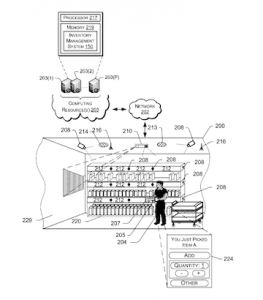Amazon Go: A New Era in Data Collection
By Joshua Smith | March 6, 2020
If you haven’t heard of Amazon Go yet, it’s Amazon’s newest concept store. The stores are not especially common with only twenty-six locations in the United States. And, the content is the same as your typical small convenience store. What makes them unique is they introduce ‘just walk out’ technology. Essentially, this means you walk in, grab what you want, and walk out without any human interaction, lines, or checkout which would be brazen theft in any other store.

Credit to forbes.com
Amazon accomplishes this customer experience with an impressive array of technology including computer vision, sensor element fusion, and deep learning according to the app and a patent. This necessarily means it is equipped with ubiquitous cameras, sensing devices, and passive scanners that Amazon seemingly has taken great care to make low-profile. Further, the technologies, and by proxy the store, are heavily data-driven and rely on the information to function. Make no mistake we’re talking about lots and lots of data.

It’s safe to assume that everything you do will be recorded, analyzed, and likely stored in some form by the cameras, sensors, and algorithms that process the data. In fairness, Amazon would be crazy not to do this from a business perspective. Learning from data is the central method to improve their product. This is a technology dependent store after all. Furthermore, Amazon has developed something many other retailers will be interested in for cost-saving, theft mitigation, and optimization. All of these secondary effects will be driven by that data.
So, what does this mean in practical terms? It likely means that when you walk into an Amazon Go store you are walking into a bit of a laboratory. Amazon will have the potential to answer with high-specificity how people shop, interact with products, and move through stores. They will also have the ability to analyze how people interact with each other and their broader environment. This data generates a growing network of questions. Are there machine detectable physical behaviors that will tell us whether someone is about to buy toothpaste? That someone is about to start a conversation with a stranger? That someone is attracted to another person? If they are, do they both have the same dating app so they can be connected? Biomarkers and personal traits could be stored and used to track and evaluate individuals. Is this person losing or gaining weight? Do their gaits indicate they are injured or have some other medical issue? What brand is that worn out sweater so we can send a link to purchase a new one?
This is speculative of course. There isn’t an outward indication that Amazon is tackling these types of problems, but they could try. For now, the microcosm of a convenience store might be too small to answer some of these questions, but it’s likely we’d be surprised what could be discovered. As this technology becomes more common and works its way into other areas of our life, we can almost guarantee that some company will try to answer these questions. With data sharing, the ability would be augmented considerably.
Ubiquitous sensor and vision data that is processed in this way isn’t something we’ve confronted at scale yet. Phones don’t really provide a useful analogy, since they’re largely confined to a pocket or bag and typically require an interaction. More analogous technology from law enforcement and intelligence agencies have made headlines with facial recognition and Gorgon Stare, but the context isn’t the same. It’s not surveillance. It’s something that is being worked into the fabric of daily life, which is an important distinction. This type of data collection represents a shift to the highly personal from a passive collection perspective. Your data will be collected by doing nothing other than being in a public space. It’s not clear what to do about this. It naturally entangles categories of data with elevated protections, privacy rights, and questions regarding the proper application of technology. However, what is clear, is this change requires careful consideration.
